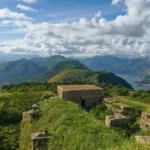Stone towns of Hvar (6): Napoleon fortress has the most beautiful view of Hvar and Vis
Everyone knows about the Fortica, or as the people of Hvar call it Španjola because it is accessible on foot from the city. But it takes a little more effort to get to Fort Napoleon or Napoljun. And that’s why many come to it by car or other means of transport. So did I, although there is also a footpath to it.
It took me ten minutes to drive from the center of Hvar to the Napoleon fortress on winding, often narrow roads. I am always fascinated by those positions on top of the hills with a beautiful view, and if there are also historical buildings on them, it is almost an obligatory urge for me to visit those locations.

Fortica and Fort Napoleon on top of the hill, Hvar, Photo: Adria.fun
Under the walls of Napoleon, there is a small parking lot where there was only one vehicle, I would say from the observatory of the Faculty of Geodesy in Zagreb, which is the only tenant of this fort.
The stars and the sun are closely followed by it. The observatory is not open to visitors, and at the time of my stay there was no one there, so I curiously rang the doorbell in vain, expecting perhaps a different turn of events.
But that’s why there is a bench under the fortress walls from which you can enjoy the most beautiful view of the town of Hvar, the Paklinski islands, and the island of Vis.

View from the Napoleon fortress on Vis and the Hvar water area, Photo: Adria.fun
Fort Napoleon is located at an elevation of 228 meters, which is 126 meters higher than the magical Fortica, so it is not surprising that back in 1807 the French decided to build Fort Napoleon on this very spot.
Admittedly, the fort was built by the hard-working population of the island for minimal compensation and under the threat that colonizing soldiers would move into their houses if they did not respond to the works.
The fortress has a rectangular floor plan with a bastion on the northern rampart and towers at the corners. A larger square tower is in the center of the fortress.

Fortress Napoleon, Hvar, Photo: Adria.fun
The hill itself got its current name Poljun after its construction, from which comes the other name of the Napoljun Fort, which I mentioned in the first sentence of the article. At the top of that hill was once the medieval church of church of St. Nicholas the Great, who is now logically gone. 🙂
Even this fort was not high enough for the French, so they tried to build another one at the nearby Velika Glava elevation, which is 330 meters above sea level, but by 1813 they only managed to lay the foundations. The reason for building the fort at this second location is even better and more transparent surveillance of the waters around the town of Hvar.

Fortress Napoleon, Hvar, Photo: Adria.fun
It is a special pleasure to sit on a bench and watch the boats, the town of Hvar and its waterfront, and the surrounding streets through binoculars, which from this position can be seen in the palm of your hand. With the naked eye, you can see the beautiful Fortica, then the cathedral of St. Stephen I and other religious buildings, and Gališnik, an islet at the very entrance to the Hvar harbor. In the port, I observed large and smaller yachts, and at the time of my visit there was also a large cruiser in front of the port.

Hvar, view from Napoleon fortress, Photo: Adria.fun
I could do this for hours, but the sun was still too strong, so even a short stay was enough for my eyes.
What bothered me a bit and spoiled the view were the various antennas of mobile operators that did not match the ambiance of this historic fort.

Fortress Napoleon, Hvar, Photo: Adria.fun
Nevertheless, I was looking forward to Vis, where we continue this series of stone towns on our islands.
This publication was co-financed by the Fund for the Promotion of Pluralism and Diversity of Electronic Media.




Leave a Reply